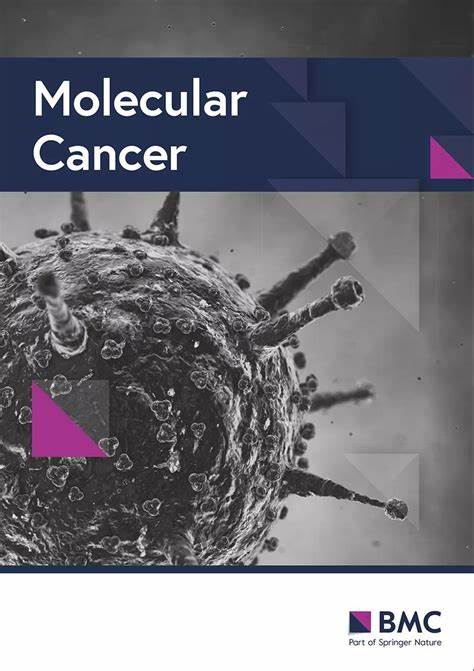Hsa_circ_0038737 promotes PARPi resistance in castration-resistant prostate cancer via IGF2BP3-mediated DNPH1 mRNA stabilization
IF 33.9
1区 医学
Q1 BIOCHEMISTRY & MOLECULAR BIOLOGY
引用次数: 0
Abstract
Resistance to poly (ADP-ribose) polymerase inhibitors (PARPi) poses a major challenge to therapeutic efficacy in castration-resistant prostate cancer (CRPC). Although circular RNAs (circRNAs) have emerged as critical regulators in cancer biology, their involvement in PARPi resistance remains largely uncharacterized. This study aims to elucidate the molecular mechanism by which hsa_circ_0038737 modulates PARPi resistance in CRPC through post-transcriptional regulatory pathways. We employed a comprehensive set of in vitro and in vivo approaches, including qRT-PCR, RNA sequencing, RNA-protein pull-down, RNA immunoprecipitation, functional assays, and xenograft/organoid models, to investigate the biological function and mechanistic role of hsa_circ_0038737 in CRPC progression and therapeutic response. We identified hsa_circ_0038737 as a nuclear-enriched circRNA significantly upregulated in CRPC, with expression levels correlating with poor prognosis and aggressive clinical features. Mechanistically, hsa_circ_0038737 interacts with RNA-binding protein (RBP) IGF2BP3, enhancing the stability of DNPH1 mRNA, a nucleotide sanitizer critical for DNA repair. The circRNA-RBP-mRNA regulatory axis promotes PARPi resistance by facilitating DNA damage repair capacity. Moreover, we revealed that reverse-complementary Alu elements mediate circRNA biogenesis, with HNRNPDL facilitating this process. Pharmacologic inhibition of DNPH1 effectively restored PARPi sensitivity both in vitro and in vivo. Our findings reveal a novel hsa_circ_0038737/IGF2BP3/DNPH1 axis driving PARPi resistance in CRPC, offering promising potential biomarkers and therapeutic targets to overcome resistance and improve treatment outcomes in advanced prostate cancer.Hsa_circ_0038737通过igf2bp3介导的DNPH1 mRNA稳定促进去势抵抗性前列腺癌中PARPi的耐药性
对聚(adp -核糖)聚合酶抑制剂(PARPi)的耐药性是去势抵抗性前列腺癌(CRPC)治疗效果的主要挑战。尽管环状rna (circRNAs)已成为癌症生物学中的关键调节因子,但它们在PARPi耐药中的作用在很大程度上仍未被描述。本研究旨在阐明hsa_circ_0038737通过转录后调控途径调控CRPC中PARPi耐药的分子机制。我们采用了一套全面的体外和体内方法,包括qRT-PCR, RNA测序,RNA蛋白拉下,RNA免疫沉淀,功能测定和异种移植/类器官模型,研究hsa_circ_0038737在CRPC进展和治疗反应中的生物学功能和机制作用。我们发现hsa_circ_0038737是一个在CRPC中显著上调的核富集circRNA,其表达水平与不良预后和侵袭性临床特征相关。机制上,hsa_circ_0038737与rna结合蛋白(RBP) IGF2BP3相互作用,增强DNPH1 mRNA的稳定性,DNPH1 mRNA是DNA修复的关键核苷酸消毒剂。circRNA-RBP-mRNA调控轴通过促进DNA损伤修复能力促进PARPi抗性。此外,我们发现反向互补Alu元件介导环状rna的生物发生,而HNRNPDL促进了这一过程。药物抑制DNPH1可有效恢复PARPi在体内和体外的敏感性。我们的研究结果揭示了一种新的hsa_circ_0038737/IGF2BP3/DNPH1轴驱动CRPC中PARPi的耐药,为克服耐药和改善晚期前列腺癌的治疗结果提供了有希望的潜在生物标志物和治疗靶点。
本文章由计算机程序翻译,如有差异,请以英文原文为准。
求助全文
约1分钟内获得全文
求助全文
来源期刊

Molecular Cancer
医学-生化与分子生物学
CiteScore
54.90
自引率
2.70%
发文量
224
审稿时长
2 months
期刊介绍:
Molecular Cancer is a platform that encourages the exchange of ideas and discoveries in the field of cancer research, particularly focusing on the molecular aspects. Our goal is to facilitate discussions and provide insights into various areas of cancer and related biomedical science. We welcome articles from basic, translational, and clinical research that contribute to the advancement of understanding, prevention, diagnosis, and treatment of cancer.
The scope of topics covered in Molecular Cancer is diverse and inclusive. These include, but are not limited to, cell and tumor biology, angiogenesis, utilizing animal models, understanding metastasis, exploring cancer antigens and the immune response, investigating cellular signaling and molecular biology, examining epidemiology, genetic and molecular profiling of cancer, identifying molecular targets, studying cancer stem cells, exploring DNA damage and repair mechanisms, analyzing cell cycle regulation, investigating apoptosis, exploring molecular virology, and evaluating vaccine and antibody-based cancer therapies.
Molecular Cancer serves as an important platform for sharing exciting discoveries in cancer-related research. It offers an unparalleled opportunity to communicate information to both specialists and the general public. The online presence of Molecular Cancer enables immediate publication of accepted articles and facilitates the presentation of large datasets and supplementary information. This ensures that new research is efficiently and rapidly disseminated to the scientific community.
 求助内容:
求助内容: 应助结果提醒方式:
应助结果提醒方式:


